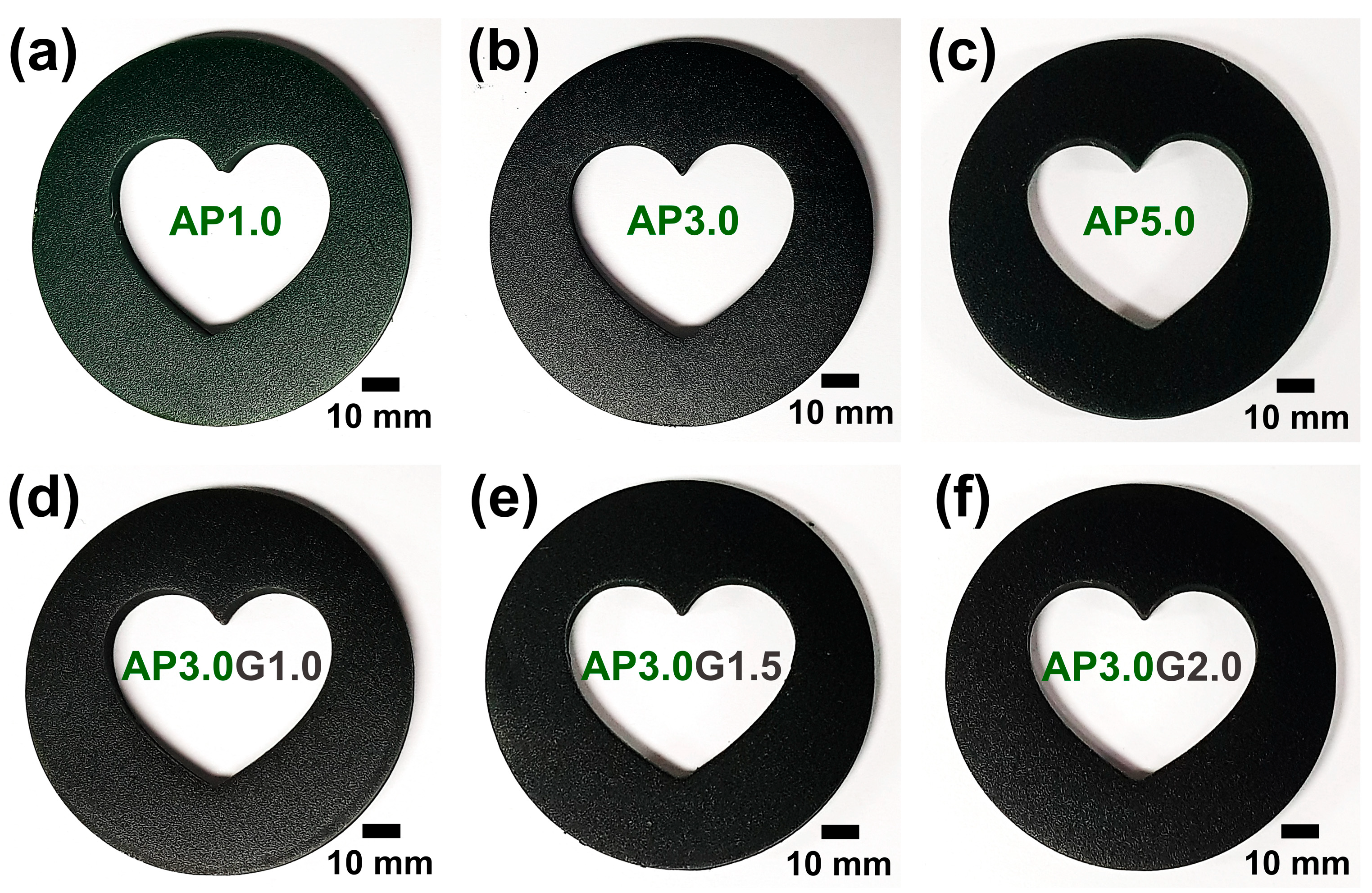The Effects of Polyaniline Nanofibers and Graphene Flakes on the Electrical Properties and Mechanical Properties of ABS-like Resin Composites Obtained by DLP 3D Printing
Abstract
:1. Introduction
2. Materials and Methods
2.1. Materials
2.2. Fabrication of ABS-like Resin Composites for DLP 3D Printing
2.3. DLP 3D Printing and Characterization of ABS-like Resin Composites
3. Results and Discussion
3.1. Studies on the Manufacturing and 3D Printing Process of ABS-like Resin Composites
3.2. Spectroscopic Studies on the 3D Printed ABS-like Resin Composites
3.3. Studies on the Electrical Properties of 3D Printed ABS-Like Resin Composites
3.4. Studies on the Mechanical Properties of 3D Printed ABS-Like Resin Composites
4. Conclusions
Supplementary Materials
Author Contributions
Funding
Institutional Review Board Statement
Data Availability Statement
Acknowledgments
Conflicts of Interest
References
- Stansbury, J.W.; Idacavage, M.J. 3D printing with polymers: Challenges among expanding options and opportunities. Dent. Mater. 2016, 32, 54–64. [Google Scholar] [CrossRef] [PubMed]
- Ligon, S.C.; Liska, R.; Stampfl, J.; Gurr, M.; Mülhaupt, R. Polymers for 3D Printing and Customized Additive Manufacturing. Chem. Rev. 2017, 117, 10212–10290. [Google Scholar] [CrossRef] [PubMed] [Green Version]
- Maines, E.M.; Porwal, M.K.; Ellison, C.J.; Reineke, T.M. Sustainable advances in SLA/DLP 3D printing materials and processes. Green Chem. 2021, 23, 6863–6897. [Google Scholar] [CrossRef]
- Mu, Q.; Wang, L.; Dunn, C.K.; Kuang, X.; Duan, F.; Zhang, Z.; Qi, H.J.; Wang, T. Digital light processing 3D printing of conductive complex structures. Addit. Manuf. 2017, 18, 74–83. [Google Scholar] [CrossRef]
- Mu, X.; Bertron, T.; Dunn, C.; Qiao, H.; Wu, J.; Zhao, Z.; Saldana, C.; Qi, H.J. Porous polymeric materials by 3D printing of photocurable resin. Mater. Horiz. 2017, 4, 442–449. [Google Scholar] [CrossRef]
- Cosola, A.; Sangermano, M.; Terenziani, D.; Conti, R.; Messori, M.; Grützmacher, H.; Pirri, C.F.; Chiappone, A. DLP 3D—Printing of shape memory polymers stabilized by thermoreversible hydrogen bonding interactions. Appl. Mater. Today 2021, 23, 101060. [Google Scholar] [CrossRef]
- Shie, M.-Y.; Chang, W.-C.; Wei, L.-J.; Huang, Y.-H.; Chen, C.-H.; Shih, C.-T.; Chen, Y.-W.; Shen, Y.-F. 3D Printing of Cytocompatible Water-Based Light-Cured Polyurethane with Hyaluronic Acid for Cartilage Tissue Engineering Applications. Materials 2017, 10, 136. [Google Scholar] [CrossRef]
- Lantean, S.; Barrera, G.; Pirri, C.F.; Tiberto, P.; Sangermano, M.; Roppolo, I.; Rizza, G. 3D Printing of Magnetoresponsive Polymeric Materials with Tunable Mechanical and Magnetic Properties by Digital Light Processing. Adv. Mater. Technol. 2019, 4, 1900505. [Google Scholar] [CrossRef]
- Chen, H.; Lee, S.-Y.; Lin, Y.-M. Synthesis and Formulation of PCL-Based Urethane Acrylates for DLP 3D Printers. Polymers 2020, 12, 1500. [Google Scholar] [CrossRef]
- Zarek, M.; Layani, M.; Cooperstein, I.; Sachyani, E.; Cohn, D.; Magdassi, S. 3D Printing of Shape Memory Polymers for Flexible Electronic Devices. Adv. Mater. 2016, 28, 4449–4454. [Google Scholar] [CrossRef]
- Du, K.; Basuki, J.; Glattauer, V.; Mesnard, C.; Nguyen, A.T.; Alexander, D.L.J.; Hughes, T.C. Digital Light Processing 3D Printing of PDMS-Based Soft and Elastic Materials with Tunable Mechanical Properties. ACS Appl. Polym. Mater. 2021, 3, 3049–3059. [Google Scholar] [CrossRef]
- Colella, R.; Chietera, F.P.; Catarinucci, L. Analysis of FDM and DLP 3D-Printing Technologies to Prototype Electromagnetic Devices for RFID Applications. Sensors 2021, 21, 897. [Google Scholar] [CrossRef] [PubMed]
- Strohmeier, L.; Frommwald, H.; Schlögl, S. Digital light processing 3D printing of modified liquid isoprene rubber using thiol-click chemistry. RSC Adv. 2020, 10, 23607–23614. [Google Scholar] [CrossRef]
- Billings, C.; Cai, C.; Liu, Y. Utilization of Antibacterial Nanoparticles in Photocurable Additive Manufacturing of Advanced Composites for Improved Public Health. Polymers 2021, 13, 2616. [Google Scholar] [CrossRef]
- Seo, J.; Hwang, J.-Y.; Ji, C.-H. Electromagnetic 2D scanning micromirror fabricated with 3D printed polymer parts for LiDAR applications. Sens. Actuators A Phys. 2022, 348, 113997. [Google Scholar] [CrossRef]
- Skotheim, T.A.; Elsenbaumer, R.L.; Shacklette, L.W. Handbook of Conducting Polymers, 3rd ed.; CRC Press: New York, NY, USA, 2007; ISBN 9781574446654. [Google Scholar]
- Jang, J. Conducting polymer nanomaterials and their applications. Adv. Polym. Sci. 2006, 199, 189–259. [Google Scholar]
- Park, H.; Kim, T.; Huh, J.; Kang, M.; Lee, J.; Yoon, H. Anisotropic Growth Control of Polyaniline Nanostructures and Their Morphology-Dependent Electrochemical Characteristics. ACS Nano 2012, 6, 7624–7633. [Google Scholar] [CrossRef]
- Sk, M.M.; Yue, C.Y. Synthesis of polyaniline nanotubes using the self-assembly behavior of vitamin C: A mechanistic study and application in electrochemical supercapacitors. J. Mater. Chem. A 2014, 2, 2830–2838. [Google Scholar] [CrossRef]
- Kim, M.; Lee, C.; Jang, J. Fabrication of Highly Flexible, Scalable, and High-Performance Supercapacitors Using Polyaniline/Reduced Graphene Oxide Film with Enhanced Electrical Conductivity and Crystallinity. Adv. Funct. Mater. 2014, 24, 2489–2499. [Google Scholar] [CrossRef]
- Acquah, S.F.; Leonhardt, B.E.; Nowotarski, M.S.; Magi, J.M.; Chambliss, K.A.; Venzel, T.E.; Delekar, S.D.; Al-Hariri, L.A. Carbon nanotubes and graphene as additives in 3D printing. In Carbon Nanotubes-Current Progress of Their Polymer Composites; InTech: London, UK, 2016. [Google Scholar] [CrossRef] [Green Version]
- Chiappone, A.; Roppolo, I.; Naretto, E.; Fantino, E.; Calignano, F.; Sangermano, M.; Pirri, F. Study of graphene oxide-based 3D printable composites: Effect of the in situ reduction. Compos. B Eng. 2017, 124, 9–15. [Google Scholar] [CrossRef]
- ASTM D638-14; ASTM International. Standard Test Method for Tensile Properties of Plastics. ASTM International: West Conshohocken, PA, USA, 2014.
- Socrates, G. Infrared and Raman Characteristic Group Frequencies: Tables and Charts, 3rd ed.; John Wiley & Sons: Hoboken, NJ, USA, 2004; ISBN 9780470093078. [Google Scholar]
- Dias, R.C.M.; Góes, A.M.; Serakides, R.; Ayres, E.; Oréfice, R.L. Porous biodegradable polyurethane nanocomposites: Preparation, characterization and biocompatibility tests. Mater. Res. 2010, 13, 211–218. [Google Scholar] [CrossRef]
- Zhang, K.; Nelson, A.M.; Talley, S.J.; Chen, M.; Margaretta, E.; Hudson, A.G.; Moore, R.B.; Long, T.E. Non-isocyanate poly (amide-hydroxyurethane) s from sustainable resources. Green Chem. 2016, 18, 4667–4681. [Google Scholar] [CrossRef] [Green Version]
- Zhou, S.; Wu, L.; Xiong, M.; He, Q.; Chen, G. Dispersion and UV-VIS Properties of Nanoparticles in Coatings. J. Dispers. Sci. Technol. 2005, 25, 417–433. [Google Scholar] [CrossRef]
- Joo Kim, H.; Raj Pant, H.; Hee Kim, J.; Jung Choi, N.; Sang Kim, C. Fabrication of multifunctional TiO2–fly ash/polyurethane nanocomposite membrane via electrospinning. Ceram. Int. 2014, 40, 3023–3029. [Google Scholar] [CrossRef]
- Yang, S.; Yue, W.; Huang, D.; Chen, C.; Lin, H.; Yang, X. A facile green strategy for rapid reduction of graphene oxide by metallic zinc. RSC Adv. 2012, 2, 8827–8832. [Google Scholar] [CrossRef]
- Huang, J.; Virji, S.; Weiller, B.H.; Kaner, R.B. Polyaniline Nanofibers: Facile Synthesis and Chemical Sensors. J. Am. Chem. Soc. 2003, 125, 314–315. [Google Scholar] [CrossRef]
- Lee, C.; Wei, X.D.; Kysar, J.W.; Hone, J. Measurement of the elastic properties and intrinsic strength of monolayer graphene. Science 2008, 321, 385–388. [Google Scholar] [CrossRef]
- Valentová, H.; Stejskal, J. Mechanical properties of polyaniline. Synth. Met. 2010, 160, 832–834. [Google Scholar] [CrossRef]
- Adhikari, J.; Kumar, R.; Jain, S.C. Using modified Halpin Tsai based approach for electromechanical analysis of functionally graded graphene reinforced piezoelectric tile. Int. J. Mech. Mater. 2023, 19, 299–318. [Google Scholar] [CrossRef]
- Adhikari, J.; Kumar, R.; Narain, V.; Jain, S.C. Electromechanical study of graphene reinforced lead-free functionally graded tile for vibration energy harvesting. J. Intell. Mater. Syst. Struct. 2023, 34, 861–876. [Google Scholar] [CrossRef]
- Kabir, H.; Aghdam, M.M. A robust Bézier based solution for nonlinear vibration and post-buckling of random checkerboard graphene nano-platelets reinforced composite beams. Compos. Struct. 2019, 212, 184–198. [Google Scholar] [CrossRef]
- Kabir, H.; Aghdam, M.M. A generalized 2D Bézier-based solution for stress analysis of notched epoxy resin plates reinforced with graphene nanoplatelets. Thin-Walled Struct. 2021, 169, 108484. [Google Scholar] [CrossRef]







| Sample | ABS-like Resin (g) | PANI Nanofiber (g) | Graphene Flake (g) | Viscosity (cps) |
|---|---|---|---|---|
| pristine | 20.00 | - | - | 375 ± 25 |
| AP1.0 | 19.80 | 0.20 | - | 385 ± 30 |
| AP2.0 | 19.60 | 0.40 | - | 390 ± 30 |
| AP3.0 | 19.40 | 0.60 | - | 395 ± 30 |
| AP4.0 | 19.20 | 0.80 | - | 400 ± 35 |
| AP5.0 | 19.00 | 1.00 | - | 405 ± 35 |
| AP3.0G1.0 | 19.20 | 0.60 | 0.20 | 398 ± 30 |
| AP3.0G1.3 | 19.14 | 0.60 | 0.26 | 401 ± 35 |
| AP3.0G1.5 | 19.10 | 0.60 | 0.30 | 403 ± 35 |
| AP3.0G1.7 | 19.06 | 0.60 | 0.34 | 405 ± 35 |
| AP3.0G2.0 | 19.00 | 0.60 | 0.40 | 408 ± 35 |
| Sample | Layer Height (mm) | Exposure Time (s) |
|---|---|---|
| pristine | 0.05 | 5.0 |
| AP1.0 | 0.05 | 5.1 |
| AP2.0 | 0.05 | 5.1 |
| AP3.0 | 0.05 | 5.1 |
| AP4.0 | 0.05 | 5.2 |
| AP5.0 | 0.05 | 5.2 |
| AP3.0G1.0 | 0.05 | 5.2 |
| AP3.0G1.3 | 0.05 | 5.2 |
| AP3.0G1.5 | 0.05 | 5.2 |
| AP3.0G1.7 | 0.05 | 5.3 |
| AP3.0G2.0 | 0.05 | 5.3 |
Disclaimer/Publisher’s Note: The statements, opinions and data contained in all publications are solely those of the individual author(s) and contributor(s) and not of MDPI and/or the editor(s). MDPI and/or the editor(s) disclaim responsibility for any injury to people or property resulting from any ideas, methods, instructions or products referred to in the content. |
© 2023 by the authors. Licensee MDPI, Basel, Switzerland. This article is an open access article distributed under the terms and conditions of the Creative Commons Attribution (CC BY) license (https://creativecommons.org/licenses/by/4.0/).
Share and Cite
Jang, S.; Cho, S. The Effects of Polyaniline Nanofibers and Graphene Flakes on the Electrical Properties and Mechanical Properties of ABS-like Resin Composites Obtained by DLP 3D Printing. Polymers 2023, 15, 3079. https://doi.org/10.3390/polym15143079
Jang S, Cho S. The Effects of Polyaniline Nanofibers and Graphene Flakes on the Electrical Properties and Mechanical Properties of ABS-like Resin Composites Obtained by DLP 3D Printing. Polymers. 2023; 15(14):3079. https://doi.org/10.3390/polym15143079
Chicago/Turabian StyleJang, Somi, and Sunghun Cho. 2023. "The Effects of Polyaniline Nanofibers and Graphene Flakes on the Electrical Properties and Mechanical Properties of ABS-like Resin Composites Obtained by DLP 3D Printing" Polymers 15, no. 14: 3079. https://doi.org/10.3390/polym15143079





